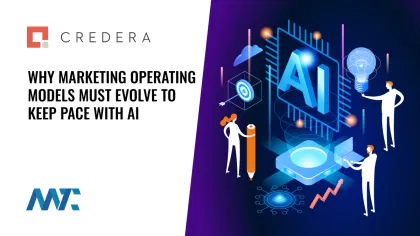Why Marketing Operating Models Must Evolve to Keep Pace With AI

It’s easy to get dazzled by the promise of AI — the speed, the scale, the seemingly endless optimization. But when marketing leaders rush to implement AI tools without rethinking the structures that support them, the result is often expensive underperformance. What’s needed isn’t just better tech. It’s a fundamental redesign of how marketing organizations operate, one that aligns purpose, people, process, platforms, and performance into a system that scales with intelligence.
The marketing teams that consistently outperform aren’t lucky. They’re engineered, intentionally designed to win, much like a casino always tilts the odds in its favor. This analogy is at the heart of a structural framework built for the age of AI:
The Five Ps of Marketing
Reengineering for Intelligence
This model draws on established organization design theory and updates it for a marketing environment increasingly driven by automation, personalization, and real-time analytics. Instead of reacting to new technologies in isolation, the Five Ps: Purpose, People, Process, Platforms, and Performance, offer a blueprint for holistic evolution.
Each of these dimensions interacts with the others. Change one without adjusting the rest, and the organization risks falling into destructive interference: duplicated effort, bloated martech stacks, and poor return on investment.
Let’s break each one down.
Purpose: Setting the Right North Star
Every transformation begins with clarity of purpose. That means identifying what marketing is solving for, whether deepening customer engagement, driving acquisition, or accelerating pipeline velocity. From there, the required capabilities can be mapped out and assessed against the current state.
Generative AI could contribute approximately $463 billion annually to marketing productivity,
McKinsey
This statistic underscores the importance of aligning AI initiatives with business goals rather than retrofitting them to disconnected tasks.
People: More Than Org Charts
Talent matters, but structure matters just as much. AI doesn’t eliminate the need for people; it changes where their attention is most valuable. Marketing leaders must rethink spans of control, geographic centralization, and skill development.
At the 2025 Cannes Lions CMO Insider Breakfast, a BCG survey revealed that 71% of CMOs plan to invest over $10 million annually in AI over the next three years, up from 57% the previous year. Despite this increase, many organizations still struggle to scale ROI, highlighting the need for smarter structural design and a clear understanding of where AI investments will have the most impact.
Process: Surfacing the Invisible
At scale, even small inefficiencies compound. Marketing isn’t just about creative and execution; it’s about legal reviews, brand approvals, localization cycles, and feedback loops, all of which need to be tightly orchestrated.
According to Nielsen’s 2023 Annual Marketing Report, nearly 70% of marketers feel confident in measuring ROI at the aggregate level, yet struggle to do the same across individual channels. That gap suggests a lack of streamlined, integrated processes, a challenge only magnified when AI systems are layered on top of fragmented workflows.
Platforms: Build for Fit, Not Hype
Too many organizations buy platforms hoping they’ll fix broken processes. But tools should be configured around strategy, not the other way around. A workflow orchestration platform, for example, is only as powerful as the governance rules and human behaviors it supports.
Forrester projects that global martech spending will surpass $215 billion by 2027, reflecting the explosive pace of platform adoption. Yet without a clear alignment to strategy and team capabilities, this investment often fails to drive value, turning martech stacks into digital paperweights.
Performance: Proving the System Works
This is where it all comes together or falls apart. Without clear metrics tied to purpose, there’s no way to know if the operating model is working. Effective performance management requires not only defining the right KPIs, but also assigning ownership, building accountability structures, and making informed trade-offs on budget allocation.
Gartner’s 2023 Multichannel Marketing Survey found that performance measurement remains one of the most persistent challenges for digital leaders, largely due to fragmented data and inconsistent definitions of success. Without a reliable feedback loop, it’s impossible to know whether new tools or structures are driving results or just creating noise.
The Trap of ‘AI First’
AI can supercharge marketing outcomes, but only when integrated into a system that’s ready to use it. Two critical missteps frequently undermine AI investments:
- Starting with tools instead of problems. The most common mistake is asking, “How can we use AI?” instead of “What problem are we solving?” Technology must be a response to need, not a strategy in itself.
- Neglecting the data foundation. AI is only as powerful as the data it consumes. Without unified, high-quality, structured data, even the most advanced AI models will fail to deliver meaningful personalization or performance improvements.
Building for Continuous Evolution
Operating models aren’t static. They evolve alongside customer expectations, organizational strategy, and technological innovation. For marketing leaders, that means moving from one-time reorgs to an ongoing rhythm of redesign and refinement.
AI has raised the bar. To meet it, marketing organizations must become systems; interconnected, intentional, and engineered to adapt. The house always wins, not because it bets on the newest tools, but because it never stops designing itself to succeed.
Key Takeaways
- AI alone isn’t enough — marketing leaders must redesign their operating models around the “Five Ps” (Purpose, People, Process, Platforms, Performance) to unlock AI’s full potential and avoid costly inefficiencies.
- Successful marketing teams are engineered, not accidental, with structures intentionally built to align strategy, talent, workflows, and tools in a scalable system.
- Common AI pitfalls include starting with technology instead of business problems and failing to unify data, which undermines personalization and ROI.
- To thrive in the AI era, marketing organizations must continually evolve in sync with customer needs, business objectives, and technological advancements.
To learn more about creating a holistic marketing framework that aligns the Five Ps in the age of AI:







